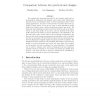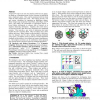14 search results - page 2 / 3 » The Lens Design Using the CMA-ES Algorithm |
ESORICS
2004
Springer
14 years 22 days ago
2004
Springer
We evaluate the anonymity provided by two popular email mix implementations, Mixmaster and Reliable, and compare their effectiveness through the use of simulations which model th...
IUI
2009
ACM
14 years 4 months ago
2009
ACM
Many websites use tags as a mechanism for improving item metadata through collective user effort. Users of tagging systems often apply far more tags to an item than a system can ...
CGF
2007
13 years 7 months ago
2007
This paper describes a fast rendering algorithm for verification of spectacle lens design. Our method simulates refraction corrections of astigmatism as well as myopia or presbyo...
WWW
2006
ACM
14 years 8 months ago
2006
ACM
Fitting enough information from webpages to make browsing on small screens compelling is a challenging task. One approach is to present the user with a thumbnail image of the full...
CHI
1994
ACM
13 years 11 months ago
1994
ACM
ToolglassTM widgets are new user interface tools that can appear, as though on a transparent sheet of glass, between an application and a traditional cursor. They can be positione...


